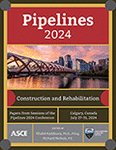A 96-in. Drinking Water Transmission Main—Clinton River Open-Cut Crossing Design and Construction
Publication: Pipelines 2024
ABSTRACT
Pipeline river crossings are challenging, require significant prior planning, and will still likely experience challenges during construction. Close coordination with project stakeholders, including regulatory agencies, customers, residents, community members, and business owners, during the planning, design, and construction stages is crucial to any project’s success, particularly with complex situations, such as pipeline river crossings. The Great Lakes Water Authority (GLWA) provides clean, safe drinking water to 88 member partners across 112 southeast Michigan communities, equivalent to nearly 40% of Michigan’s population. GLWA is in the design and construction phases of the relocation of a 96-in., 2.5-mi drinking water transmission main around a closed industrial landfill, near Shelby Township, Michigan. The 96-in.-diameter pipeline serves over one million people in southeast Michigan. The first phase of the project includes 2,220 linear feet of water transmission main (WTM) and roadway improvements across the Clinton River and through a major intersection and adjacent popular, seasonal business. The Clinton River crossing will be the focus of this paper. This paper will discuss the collaboration of the Project Team for the execution of this crossing: GLWA, Jacobs (the Engineer), and Kiewit [the Construction Management at Risk (CMAR) Contractor]. During the project planning phase, GLWA and the Engineer conducted an alternatives analysis to make the determination between open-cut and trenchless crossing of the Clinton River. In coordination with Michigan’s Department of Environment, Great Lakes, and Energy (EGLE), GLWA and the Engineer selected open-cut as the crossing method, to be discussed in the paper. Due to the extensive process and long permitting schedule, GLWA and the Engineer involved EGLE early in the planning and design phases to inform and coordinate prior to the permit submittals, including field visits and discussions. During the design phase, the Engineer developed a conceptual layout and technical requirements for the crossing and obtained the wetland and floodplain permit from EGLE. This included flood modeling, scour analysis, pipeline alignment (for pipe pre-purchase), and river restoration coordination. Once the CMAR Contractor was under contract, they used the Engineer-provided flood model, technical requirements, and permit-required analysis to design the cofferdam and crossing. The construction phase occurred between November 2022 and September 2023. As can be expected with river crossings, there were challenges that arose, and the Project Team worked together to solve the challenges. The resolution of these challenges along with lessons learned throughout the process will be detailed in the paper.
Get full access to this chapter
View all available purchase options and get full access to this chapter.
Information & Authors
Information
Published In
History
Published online: Aug 30, 2024
ASCE Technical Topics:
- Construction engineering
- Construction management
- Design (by type)
- Drinking water
- Electric power
- Energy engineering
- Engineering fundamentals
- Hydraulic design
- Hydraulic engineering
- Hydraulics
- Infrastructure
- Pipeline management
- Pipeline systems
- Pipelines
- Power transmission
- Project management
- River crossing
- Water (by type)
- Water and water resources
- Water management
- Water pipelines
Authors
Metrics & Citations
Metrics
Citations
Download citation
If you have the appropriate software installed, you can download article citation data to the citation manager of your choice. Simply select your manager software from the list below and click Download.
